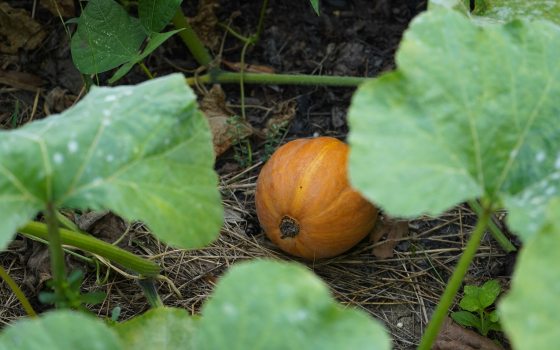When you think of autumn in a garden, pumpkins and squashes most likely come to mind—and for good reason! From their flavors to their frequent use as seasonal décor, these garden stars are quintessential to the fall season—and a number of interesting and home gardening-friendly varieties are also gracing our Ornamental Kitchen Garden at this very moment. Follow along as we share more about these festive fall favorites, how to grow them at home, and how we’ll soon be featuring their flavor here at Longwood in what may be a very unexpected way.
Several of the most popular varieties grown in the home garden (and in our Ornamental Kitchen Garden) belong to the squash family (Cucurbitaceae). Commonly called cucurbits, these vining plants include winter and summer squash, gourds, cucumbers, melons, and luffas. Cucurbits can sprawl on the ground or be grown on trellises—they also make an excellent groundcover or “living mulch” underneath tall crops. Here in the Ornamental Kitchen Garden, you’ll find winter squashes like ‘Lodi’ and a local landrace from the Nanticoke people used as groundcovers, as we allow their long vigorous vines to sprawl across multiple garden beds. Others, like our long bottle gourds, are grown on a trellis so they can hang and grow into a long straight fruit, rather than turning into the twisted forms that occur when grown on the ground.
Most cucurbits prefer hot weather and should be planted after frost, and most should be direct-sown. They can be grown as transplants (meaning you start the seed indoors), which is recommended practice for long-season tropicals like gourds and luffas. Cucurbit roots are sensitive to transplant shock and will be very unhappy if you let them get rootbound in pots before planting outside. It will take only two to three weeks from seed to transplant, so don’t sow indoors more than two to three weeks before planting outside. I much prefer to sow my seed directly outside, as I find the plants generally do better.
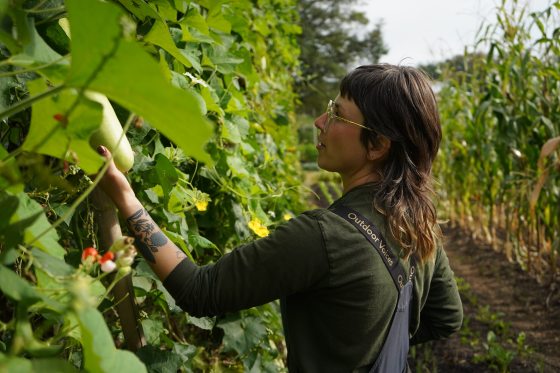
Senior Horticulturist Alex Correia checks progress on a bottle gourd in the Ornamental Kitchen Garden. Photo by Carol Gross.
We use the term “summer squashes” to describe those cucurbits that are picked before they are mature—when the fruit is small, the skin is tender, and the seeds are small. Summer squash include zucchini and yellow squash, as well as pattypans and delicata squashes—all of which are examples of the Cucurbita pepo species that we grew in the Ornamental Kitchen Garden earlier this year. Summer squashes are harvested throughout summer, and require picking every two or three days before they are overmature. A baseball bat-sized zucchini might feel like a great garden achievement, but they are much less desirable for eating due to their large seeds and thick skin. The delicata squash, on the other hand, is harvested once when the fruit is mature and the skin has turned from green to yellow. Eaten more like a winter squash and in season in early fall, delicata squash are still in the same species as our summer squashes and their skin is so delicate that it can be eaten, making it a breeze to prep in the kitchen. The Cucurbita pepo species feature vines that do not grow very long and do not require trellising, making these a wonderful option for small-space gardens.

Among my favorite varieties of summer squashes grown in the Ornamental Kitchen Garden this year was Curcurbita pepo ‘Dark Star’—an heirloom that is tender and slow-growing, making it perfect for the home gardener and chef. Photo by Alex Correia.
To grow summer squashes, direct-sow them after the last frost. Additional successions can be planted through July. These squashes are harvested throughout summer, and require picking every two or three days before they are overmature. Summer squash are susceptible to bacterial wilt and downy or powdery mildew. To help prevent these diseases, we promote good air circulation around the foliage by giving plants adequate space and by trying to avoid wetting the leaves when watering. As summer squashes are harvested before they’re mature, they have a shorter shelf life and are best enjoyed soon after picking.
Senior Horticulturist Alex Correia gives a quick tour of the gourd trellis in the Ornamental Kitchen Garden.
The term “winter squashes” is used to describe those that are picked at full maturity. They have thick skins that allow them to be stored over the winter, and include pumpkins, butternut squash, spaghetti squash, and more. Winter squash species include Cucurbita maxima and Cucurbita moschata—their vines get very, very long and they need a lot of space to spread out, so you will need to allow for plenty of space for them to trail. Winter squashes should be direct-sowed after frost (sometime around May in this area) into hills or rows and harvested when the skin has fully changed color from green to the expected skin color for the variety. It’s best to wait until the vines themselves die down and only the ripe fruit remains in the field; just like you would see if you went picking at your local pumpkin patch. Be aware, however, that the longer the fruits stay in the field, the more likely a rot will set in or a hungry critter will damage them. Just like summer squashes, winter squashes are susceptible to bacterial wilt and downy or powdery mildew. Winter squashes can be stored for months and should be kept in a cool, dry place for long-term storage; wiping freshly harvested squashes with diluted bleach before storage can help extend their shelf life.
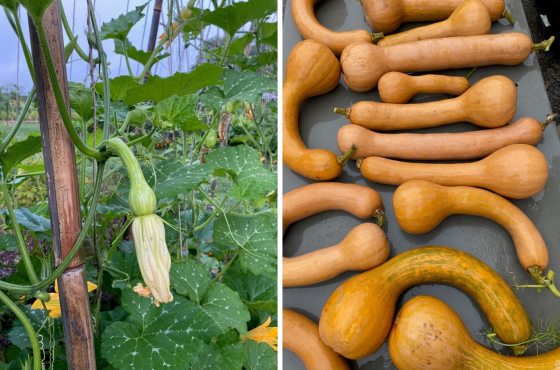
One of my favorite winter squashes is Cucurbita moschata ‘Tromboncino’, which is delicious eaten when it is young and just 8 inches long. However, if you forget to pick them and allow them to get fully mature, you will have a huge, long-necked winter squash for winter storage. The above images show a similar variety called C. moschata ‘Centercut’; the left at immature harvest stage and the right at mature stage, where it can be eaten like an oversized butternut. Photos by Alex Correia.
Just in time for squash season, we are featuring a new brew as part of our partnership with Victory Brewing Company. A delicious autumnal brown ale featuring notes of toasted nuts, roasted squash, caramel, and brown sugar, Longwood Seasons: Equinox, will be available in our Beer Garden beginning in early October.
Gourds are another type of cucurbit and are known as the species Lagenaria siceraria. Gourds grow extremely long and do best on large, sturdy trellises. Some, like cucuzzas and bottle gourds, can be harvested when young and cooked as one would a summer squash. At full maturity they become hollow and can be used for fall décor, carving, and reuse as bowls. In the Ornamental Kitchen Garden, we are currently growing cucuzzas, bottle gourds, birdhouse gourds, and luffa gourds—whose dried fibers on the inside are used for luffa sponges!
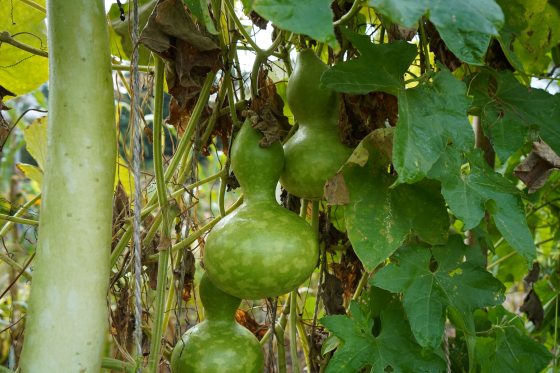
Birdhouse gourds and cucuzza squash grow alongside one another in the Ornamental Kitchen Garden. Photo by Carol Gross.
One fun variety to note is the winter melon, or wax gourd (Benincasa hispida). A very popular vegetable in Asian cooking, the winter melon—whose name comes from the fact that it has a waxy coat that preserves it over the winter— has a texture like a winter squash and is often featured in soups and curries. Our winter melons are currently hanging from burlap melon hammocks on our Ornamental Kitchen Garden fencing—it’s a great way to help support them as they grow and before we harvest them by the end of September.
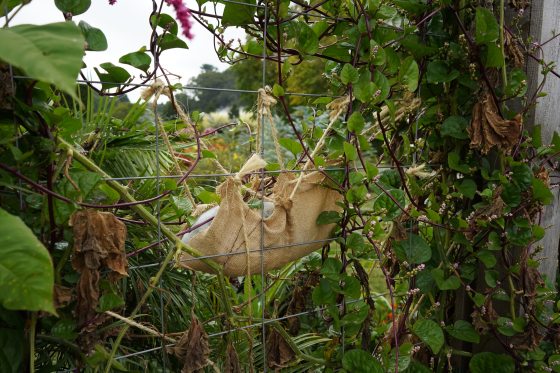
A winter melon hangs on our Ornamental Kitchen Garden. Photo by Carol Gross.
Commonly grown cucurbits are highly susceptible to pests and disease like powdery mildew; the best way to prevent damage is to follow good cultural practices like crop rotation and not getting the leaves wet, as well as planting extra and planning to lose a few plants here and there. Common pests including squash bugs and cucumber beetles won’t do too much damage, but can spread diseases like bacterial wilt. Squash vine borer is a moth whose larvae can chew through the stem of the plant at the base; sometimes plants will grow through this, but other times won’t survive. Cucurbita maxima is resistant to this pest.
A collection of less common cucurbit species can sometimes perform better than the more commonly grown species—as well as offer new possibilities in the kitchen and prove to be fun to grow! One example we’re growing now is the Mexican sour gherkin (Melothria scabra).

One example of a less common cucurbit is the Mexican sour gherkin (Melothria scabra); it tastes like a bite-sized, tart cucumber. Photo by Carol Gross.
We’ll be featuring select cucurbits in our Ornamental Kitchen Garden until the end of October—so be sure to stop by and see their beauty and variety before then! Plus, starting in early October, savor the flavors of fall with Longwood Seasons: Equinox in our Beer Garden.
